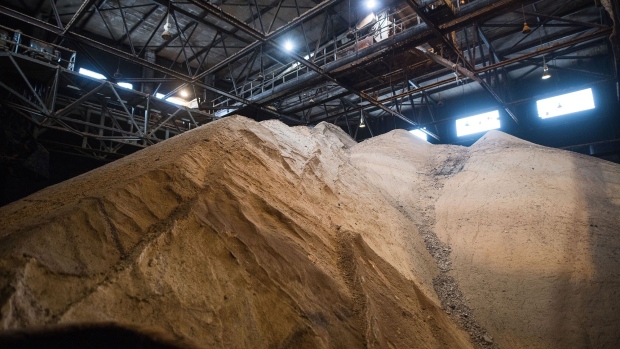It’s getting harder for companies to hide their dirty secrets.
Regulators around the world are increasingly forcing them to disclose their carbon emissions, along with other key climate change considerations such as how much financial risk they face.
Momentum is building as the rising dangers from wildfires, droughts and floods become harder to ignore, and as the alphabet soup of disclosure regimes get boiled down to clear international standards on the key questions companies most need to answer.
But while both the need and the path forward are getting increasingly clear, experts say Canada is falling behind.
At this year’s UN climate conference in Dubai, Mark Carney, the former Bank of Canada governor and a central player in global climate finance, was talking excitedly about the reporting framework established -- in record time -- by the International Sustainability Standards Board.
“Now countries are starting to implement. It’s been endorsed by the securities regulator IOSCO, the European Union, the U.K., Singapore, Switzerland, Canada,” he said, before pausing.
“Well, Canada’s lagging a bit. But most of the others are starting to implement.”
Whether a slip or a dig, his comments echo what others have been saying about Canada's pace of rolling out rules that will make it much easier to see who the laggards are on action, and where investments are most at risk.
“We're languishing,” said Janis Sarra, a principal co-investigator of the Canada Climate Law Initiative, who noted that even emerging economies like Brazil have already adopted the new standards.
Clear Canadian disclosure rules are needed, said Sarra, to make sure the country is meeting its decarbonizing commitments, to attract foreign investment, to make sure companies aren’t greenwashing and to ensure the overall stability of the financial system.
Companies ranging from banks to grocers have already started to report some climate measures. But with it all voluntary, they’re using different standards, or changing their methodology to look better, all of which makes it hard to compare companies to each other, or even to their own previous reporting, she said.
And of course, many companies choose not to disclose anything at all.
“There’s no regulatory stick, if I can call it that, that makes sure that there's integrity,” said Sarra.
“Voluntary was fine for 10 years ago, but this is urgent now.”
The Canadian Securities Administrators did release a set of proposed rules in 2021 that would make public companies report emissions and other key metrics in annual filings. The rules seem stuck in limbo.
In early July this year, the CSA welcomed the new global standards, saying an update on their own path would follow in the "coming months."
Nearly six months later, there have not been any updates. The message from CSA spokeswoman Ilana Kelemen was still that an update was forthcoming, and Kelemen said she was unable to set up an interview so someone could explain the delay.
One potential reason is the ongoing work to adapt the international standards for Canada, which the accounting industry-funded Canadian Sustainability Standards Board is doing.
The board expects draft rules out by March, and to have them set by the third quarter next year, said Charles-Antoine St-Jean, board chair.
He said Canada isn't so far behind, and is still moving fast to implement the important rules.
“The big push is really to reduce the noise ... to see some discipline, quality and integrity in the reporting system.”
Maybe the biggest snag, though, is that the U.S. securities regulator has also had an extended delay in rolling out rules.
Business groups in that country have vocally pushed back against the agency’s proposals as onerous, especially the potential need to report not only a company's direct carbon emissions, but also those carbon linked to their products and services.
In making the proposal, Securities and Exchange Commission chairman Gary Gensler said the emission disclosures rest on the foundation of modern securities law.
“Our core bargain from the 1930s is that investors get to decide which risks to take, as long as public companies provide full and fair disclosure, and are truthful in those disclosures.”
Canada's securities regulators like to align standards with the U.S., so Canadian regulators are delayed in part by waiting for an SEC decision. Even so, other juristictions are moving ahead.
California passed its own disclosure laws in October that require full emissions accounting for any company with over US$1 billion in annual revenue, public or private, that does business in the state.
The law, along with ones in the European Union that require even more disclosure and have lower business-size thresholds, are part of a thickening web of regulations that will catch an increasing number of Canadian companies, even if rules continue to languish at home.
“The overall theme that we've been telling our clients is, 'Get ready,'” said Don Linsdell, national leader of climate change and sustainability services at EY.
“Because whether you like it or not, you're going to get captured one way or the other.”
Some rules are also moving forward in Canada, including by the banking regulator that issued final guidance on climate disclosures in March.
The Big Six banks will be the first to fall under the mandatory disclosures in Canada next year, followed by all federally regulated financial institutions a year later, actions Canada’s Auditor General noted were overdue and don’t go as far as peers.
The federal government also promised in its fall economic statement that it would work to develop ways to make climate disclosures mandatory for private companies.
But as Canada starts to move on basic disclosures, other countries keep pushing forward on the next important step: requiring companies to set clear climate plans that explain how they actually plan to pollute less.
"When you think about disclosure, it's just the diagnostics," said Canadian senator Rosa Galvez. "So you are just disclosing your vulnerabilities, but you are not reducing your emissions."
Galvez has been pushing a bill that has a full wish list of measures climate advocates have been asking for, which is currently being examined by the senate banking committee, but otherwise there's little sign of rules coming to force full climate plans.
Companies are starting to voluntarily set out climate plans, but those too are falling short.
A report released last week by the financial industry-led Climate Engagement Canada found that of Canada's 41 biggest companies in grocery, rail, aviation and resources, only a third had even partially set short-term emissions targets, and none were directing spending where it needed to go to meet the goals.
Sarra at the Climate Law Initiative said that while it's important Canada catch up on disclosures, it has much further to go.
“We are going to be in serious trouble as an economy and also frankly, our biosystems and everything else, if we don't have a concerted set of transition plans across the country.”
This report by The Canadian Press was first published Dec. 18, 2023.


